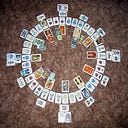The Hierophant: Theocratic Frontman or Harbinger of a Higher Purpose?
The Hierophant is another card of the Major Arcana with which I take issue, primarily because I’m highly skeptical of the arguments and orthodoxy of all religious faiths of the monotheistic, patriarchal (specifically Abrahamic) type. I don’t believe spirituality can or should be put in a dogmatic “box” of any kind, it flows freely through all levels of existence in a form of Spinozan “immanence” and is available to anyone with the eyes to see and the ears to hear, independent of sacred texts and their catechisms. I’ve never needed an interpreter to decipher and dispense its subtleties for me, the main purpose of which seems to be the foisting of “group think” on the gullible rather than illumination. When asked if I’m a “man of faith,” I reply “No, I’m a man of certainty;” all I have to do is step out my back door into the natural world and I’m flooded with this magical essence. For those reasons I’ve limited my interpretation of the card to considerations of traditional or conventional values when it comes up in a reading. In that sense, the familiarity of the “known quantity” is one of its more common implications, along with the existential comfort and security that can create. No surprises here, just reinforcement of the status quo and “toeing of the party line.”
Esoterically, the card corresponds to the astrological sign of Taurus, a Venus-ruled Earth sign that is both fertile and thoroughly mundane. It has both feet planted firmly on the ground and seldom raises its sights above the horizon. To me it never seemed like a convincing choice to represent the grander aspirations of the Hierophant, in which he endeavors to place his finger on the pulse of Divine wisdom (it is, however, perfectly symbolic of his flock of fundamentalist “true believers”). But while rereading Alejandro Jodorowsky’s The Way of Tarot I received a little more inspiration regarding the “higher calling” of Taurus: the only function of fertile soil is to facilitate the growth of vegetation which, like the Hierophant, climbs toward the light. Taking the two together, the advice might be to emulate this impulse for growth by launching a new enterprise with practical intent but perhaps with a nobler purpose in mind.
Rather than waiting for the Hierophant to enlighten us, we can strike out on our own to seek a personal epiphany. Instead of starting an ordinary relationship that satisfies the needs of the moment, we can pursue a more significant “union” (one of the keywords for the Hierophant); instead of chasing a new job in our current field, we can search for a new career in a different discipline that offers greater satisfaction; instead of being content with “plowing the same furrow,” then sowing, nurturing and harvesting the same crop year-after-year, we can acquire the education to advance our more ambitious goals in life. The “sky’s the limit” when the Hierophant makes an appearance as long as we don’t try to shoehorn our perspective into his parochial narrative. Why should we “stay on the page” when there is a whole unwritten volume before us?
In language that is more lucid and less surrealistic than is his wont, Jodorowsky spoke of the transcendent portal of the Hierophant as “the door that all keys may open.” He waxed a bit more (absurdly?) poetic in putting words in the Hierophant’s mouth but still offers compelling support for the position I’ve taken here:
“Within me is the same order found in the universe. I am an empty, shapeless vessel that transports the light wherever the wind wills. I place myself between Heaven and Earth, I urge its inhabitants with the hope of raising themselves to where there are no longer any limits. To everything that is rooted in matter or mind, I communicate the higher power that gives life to what is inanimate. Whoever has thirst may come drink from my spirit. I refuse nobody anything. He who has entered my soul can advance to the uttermost limit of the universe and to the end of time: I am the final frontier between words and the unthinkable.”
Like all earthbound entities (assuming we accept the Taurus link), the Hierophant is not a spiritual master with nothing left to learn but a fellow aspirant in his own right, just a few steps farther up the path to revelation than the rest of us but still pushing the Emperor’s secular agenda. (See my previous post, The Emperor and the Hierophant.) Given his position in the sequence, maybe we should consider him a “Hermit-in-training.” Personally, I would rather place my trust in the subtle profundities of an ascetic philosopher than in the commonplace platitudes of an anointed “holy man” who puts his pants on the same way I do. It’s like the “Wizard of Oz” version of ordainment: some reputed authority has granted credentials to a candidate who has demonstrated a certain degree of . . . what, piety? humility? obedience? . . . so we should listen to him (or her) as the mouthpiece of God? It’s as if those who wrote “the Book” wanted to retain the rights to selling its secrets in perpetuity, and they’ve done a damn good job of prepping their salesmen for it over the last few centuries. My favorite version of this card is by Brian Williams, who titled it “Mr. Religion” and depicted a butcher selling hams and sausages, with his “screaming mouth” reminiscent of Irish artist Francis Bacon’s recurring motif. (See “Head Surrounded by Sides of Beef” for its direct inspiration.) It appears this pontiff “doth protest too much,” and should stop pushing the pork and just retire to his scriptures.
PoMo Tarot by Brian Williams, copyright of HarperCollins Publishers, 10 east 53 Street, New York, NY, 10022
Originally published at http://parsifalswheeldivination.wordpress.com on November 29, 2022.
